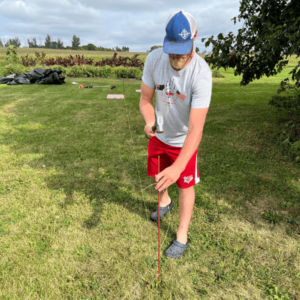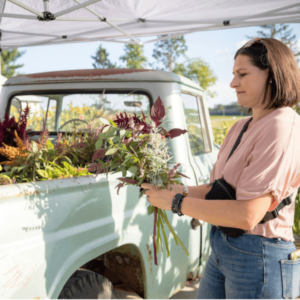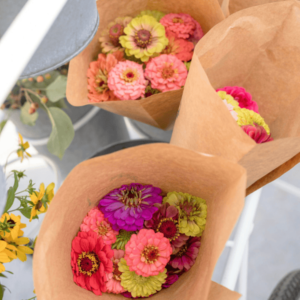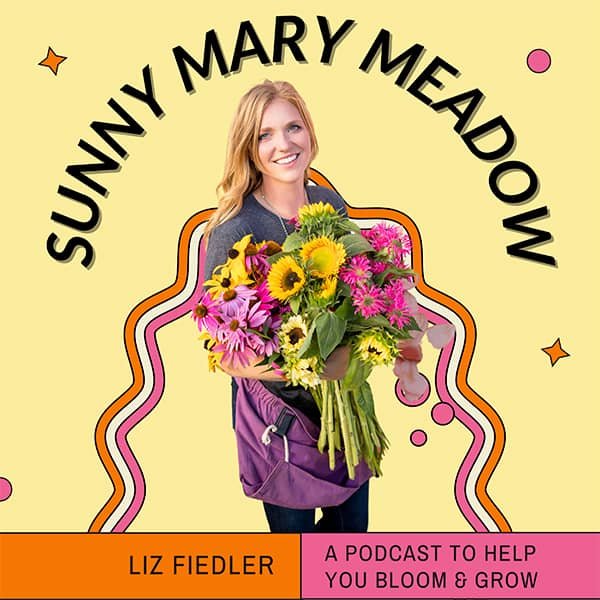
Hello everyone; this is Liz Fiedler. Welcome back to the Sunny Mary Meadow blog. Recently, we’ve talked about how I decide what to order and how I start categorizing them. I have all my lists and inventory … What do I do with them now? Well, I have to prioritize what I need to plant and when. That’s the first step to getting organized. Then the next step after that is deciding WHERE I’m going to plant things.
I want to give you a little idea of what my farm and property look like. So, when you come into the yard, the house is in the very center of the yard. My yard itself is about four acres, which is huge. It’s a 130-year-old century farm, so there are like 18 old outbuildings, and it’s just a very big old farm. Not very many usable buildings, but they’re there collecting junk (and I promise the good junk has been removed – we need dumpsters). To the east of the house, down on the meadow, I’ve got 18 rows that are four feet wide and 60 feet long. There are six feet of grass in between each row that is going to be a mix of you-pick flowers. When people come, and they’re going to pick their own bouquet, those are the flowers that I want down there. Keep in mind, I’m not putting really many dahlias down there or lisianthus, and probably not even a ton of sunflowers except for on-the-edge rows because once sunflowers are picked, they’re an ugly stemless broomstick. So that’s the you-pick section … Even though it’s definitely stuff that I’m harvesting for bouquets myself, whether it’s subscriptions or the buckets for stem bars. It’s basically stuff that is easy to pick, and I would trust the public not to damage the rest of my flowers.
There’s a big peony section down there that’s roughly the same size. One thing that we haven’t really touched on is, yes, I have like 11,000 tulips, but those are pretty much done by mid-May. (Tulips are going to have their own post.) So, when I’m talking about subscriptions and flowers and you-picks, I’m talking about the summer months. We’re going to do some entire episodes on tulips (really get to the nitty gritty), but when I’m talking about the you-pick section, you have a starting point in your mind.

On the south end of my property, we have what used to be the vegetable garden of the farm. I would say it’s probably 30 feet long. No, that would be 10 yards … it’s much longer than that. It’s probably 20 yards long by maybe 15 yards wide. It’s something like that. And there is a trellis of grape vines to the west of it. So that does get a little bit of afternoon shade over in that section.
Then up on the far west end of the property, I have a high tunnel that’s 16 x 50. Again, in the summertime, it gets hot in there. You can raise up the sides, but it stays pretty hot in there, and it’s gonna need its own drip irrigation. But … when everything else dies at the end of September, unless it’s cold-hardy, hopefully, it doesn’t freeze in there. Then I’ll have those flowers longer. I’m getting married the first week of October here in Minnesota, so anything that’s not cold-hardy that I want for my wedding, I’m planning to plant in the high tunnel so that it doesn’t die of frost. Things such as zinnias, cosmos, etc. I will do a couple of rows of those plants in the high tunnel and just kind of hope for the best.

In part one of this episode, I’ve already told you about my spreadsheets – plugs, my list of seeds that I start directly in the ground, and seeds that I started in trays. When I try to decide what to plant and where, I know that the field to the south gets a little bit of afternoon shade, but not too much.
Last year, I used black plastic landscape fabric that I burned holes in for a weed barrier, and it worked really well, so I’m doing it again this year. It also helps thaw the ground quicker because that black fabric heats up from the sun. So, last year I was able to till that up weeks before everything else. In mid-April, I will rip it off and then add compost to it because it needs nutrients. Then I can till that up, and that’s my cold-hardy area. Anything that I’ve talked about being able to plant as soon as the ground can be worked goes down there. It works really well, and a lot of those plants, like the orlaya, bupleurum, and stock, are finished about mid-July. Those are my June flowers that I sell, in addition to the peonies and ranunculus. But as I said, those don’t really fit in this category of the you-pick because they’re more specialty plants that are going to need to be their own episode. As I said, using that black fabric works really well to trick mother nature into thawing the ground a little bit sooner.

So, I look at everything and think … is it cold-hardy? Does it have to be after the last frost? Does it need to be direct-seeded? Then I just try to divide up water requirements … is it something that’s a little more drought tolerant? I do have drip lines inside of the high tunnel, and I have some drip lines down in the you-pick area, but not everything needs a ton of water. The sunflowers, the celosia, and a lot of the others are pretty drought-tolerant. So, if they’re drought tolerant, I can put them in a row that I know is not going to need a ton of water.
I look at bloom time, which we discussed in the first post. Essentially cut flower farms, true cut flower farms, have to decide if they will have people visiting or not. At mine, I want people to visit, but not until July because it’s pretty ugly around here until then. That being said, I want to alternate the rows of stuff that need to be fully opened versus those that need to be picked right when the pedals are lifting. Otherwise, if you’re picking the flowers right when they’re starting to open it looks pretty ugly. For example, a row of statice, a row of zinnias, a row of celosia – all need to be picked when they’re open. Even the snapdragons have to be at least a third open. So, it’s nice to have those alternating rows versus stuff that has to be picked earlier. Otherwise, it’s just going to look like a row of leaves. Balance out the blooms.

Then I decide how needy the type of flower is with harvest requirements. For example, with basil, I put it into a bucket of hot water when I pick it, let it sit for at least 10-15 minutes, and then move it to a bucket of cold water. That works pretty well for me, but I don’t have hot water down in the you-pick section. Because of that, I don’t want my customers to pick something that’s so needy because if they pick it and they don’t put it in hot water, they bring it home, and it droops. Then they’re upset, and rightfully so. Therefore, I put that in what I guess we’ll call my “needy section” over on the west side of the house, where I put my dahlias and lisianthus. Those are just really expensive, more premium cuts. When I’m doing a tour of the farm or I’m showing people, I definitely will let them wander over there, but I’m the one that’s cutting from those sections. It will be me, Lindsey, or some of our volunteers that are here to make sure that those don’t get mixed in with the you-pick section.
Keep in mind location and sun requirements, too. You don’t want to plant amaranth, which gets really tall (like five feet tall), next to statice, which is really short. It’s just going to throw shade on it. However, I can get by with it pretty well because I have that six-foot-wide strip of grass between the rows. Just keep in mind what’s going to be shady. Another example is that you don’t want to put sunflowers right next to the zinnias. The zinnias want heat and sun, but if they’re just to the north of a huge row of sunflowers, it’s going to be shady. So, keep in mind the continuous blooms, the shade, and the support.

We’ll have a whole post about support in a future post, too. You definitely want to have something if it’s a really windy area. I use different methods of support …there’s a corral method where you are essentially using T posts and string and make a perimeter support fence to hoist up the outer plants. This photo is from my friends’ flower farm a few hours away, Blooming Creek, where they corral their dahlias. And you want to do a couple of different levels because that canopy of flowers can get really heavy, and one big rainstorm can knock the entire thing down. Another option would be to use plastic netting. Lisianthus can be blown over in the wind really easily, so I’m putting that inside of my high tunnel. I use this support netting for lisianthus and snapdragons.
In the south garden that I talked about, which is going to be finished around mid-July with those early bloomers (orlaya, bupleurem, etc.), I’m going to throw some seeds in the ground that I know will bloom by the time it’s the last frost, so I am going to do some sunflowers in there. As long as I get them planted by July 15th, they will for sure bloom by September 15th. That should be by the time the last frost, but if I want to put in cosmos or zinnias, which can take about 90 days, July 15th would be too late. If I had another tray of stock or something that likes it cool in the fall, that would work, too. I’m pretty sure what I’m going to end up planting down there is going to be ornamental kale. That does really well with a frost. It needs a little bit longer, but they’ll be ready to go by mid-October. It just takes some thinking about what your harvest needs are going to be.

There are a lot of factors to keep in mind, and you’re going to have to decide what’s most important to you. For me, honestly, I have such a beautiful property. We’ve put a lot of work into it – we have these really pretty outbuildings, and sunrises and sunsets, that my customers don’t mind walking from one garden to the next one, or from one field to the next. I don’t put as much worry into that … the flowers are going to be where they are. Customers will go to them. They understand, and they appreciate it when it’s authentic. And when I say, “Hey, I know you expected these blooms to be everywhere, but they’re not because that’s not how it works … and we’re picking these, and we’re picking them now.” I am going to be a lot more focused on what I need to be picking … what we use the most of. For the most part, I’ll have a lot of zinnias down in the you-pick section, but I’m definitely going to put some up on the western edge of the property, too, because that’s where my workspace is, and I don’t have to go so far to go to harvest them.
Keep in mind the placement of anything that needs to be harvested in hot water. Also, keep in mind where your compost pile is because when you’re harvesting, you’ll want to rip the leaves off when you pick a stem, and it’s best to do it in the garden/field. You want to strip off all of the leaves that are going to be below the waterline and put them in a bucket and then pour that bucket right on your compost pile. If you do it in your workspace/when you’re inside, you’ll have bacteria growth. You also don’t want to do it in the garden in between the rows because then your customers are trying to walk, and they’re stepping over this decaying pile of leaves. You’ll also want to keep in mind where your workspace is. We are in the middle of remodeling the butcher shop here at the farm. Actually, I shouldn’t say we’re in the middle … we’re in the early stages. I have it all planned out, and I have a contractor coming out. I’m really excited to do a post on basically completely changing up where the center hub of the farm is and where things get done. I’m focusing on efficiency so that I can do it all from the same central location, and I’m pretty excited about that.

Abbey, what questions do you have about how I decide where to plant stuff?
Abbey:
First question. So back to tarping over your area with landscape fabric for your cold-hardy plants. Is that something that you can also do for your other gardens? Or is it just totally unnecessary? Since you’re planting later?
Liz:
It’s really unnecessary because while it’ll heat up the soil a little bit sooner, for things like zinnias, if they get down to 32 degrees, they’ll die. So, since I can’t plant them any sooner anyway, it doesn’t really matter if that ground is tillable sooner or if I can work the ground sooner because the ground is thawed sooner. And the soil temperature is warmer, but the air temperature is still going to be too cold. Whereas, with the ones I was talking about, if the ground temperature can thaw sooner and I can get the ground worked up/ dug up, those plants are fine down to about 20 degrees. So that’s why you can’t cheat Mother Nature that much. You can do things like low tunnels, which we’ll do a whole post about, but basically, that is focusing on season extension. There is a book by Lisa Mason Ziggler called Cool Flowers. In it, she talks about just using natural techniques to plant flowers sooner, but it’s a little tricky in zone 4. I think she’s in zone 5 or 6, out east. So, she does things like overwinters and covers them with straw. I mean, the actual temperature is 20 below for a lot of the winter, so that wouldn’t work here. They would die. It’s good in theory, and I can incorporate some of the techniques and plant things a little earlier, but I definitely can’t overwinter them here the way she can. So, essentially, it wouldn’t help to plant those any earlier. You cannot plant them any sooner than your last frost date.

Abbey:
Okay, next question … explain to me what a drip line is.
Liz:
We’re gonna do a whole post on irrigation, but imagine I have a row of flowers, a row of grass, a row of flowers, a row of grass … the four-foot wide end of those is on the west side of that field. So, I have a 100-foot line (it’s kind of a hose), and you poke holes into it every couple of feet. Then there’s a 60-foot hose with a hole in it every nine inches or so that just seeps out water. So, it’s called drip irrigation, and I put it underneath the fabric, and then it just irrigates the entire plant under the fabric. I did it on top of the fabric two years ago, and it was a disaster! We’ll talk about why it was a disaster in the irrigation post later, but just trust me, put it under the fabric. For cleanup and absorption, put it under the fabric, but don’t poke any holes in it with the garden stakes. Again, there’ll be a whole episode. So that’s what drip lines are.

Abbey:
Okay, then the last question I have, with this being a customer experience, when they’re here on your property, how are you going to go about labeling your you-pick area and your different gardens?
Liz:
This will be the first year that I’m offering that experience. So, everything will be supervised this first year. It’ll be me or Lindsey just walking them through, and we can show them the stuff they can and can’t pick. As I said, maybe it will include that everyone gets a couple of sunflowers, so we’ll bring a bucket down there because we know people want sunflowers. But if it’s lisianthus or dahlias, we can say, “If you want them, let me know, and it will be a couple of bucks per stem.” Otherwise, everything down in that section is completely good to go. I think I said this in the last post … I love rules. I love policies. But most people don’t. I accept that, and I understand that. When you tell people the rules, sometimes they’re not trying to break them, but they’re focused on the flowers that they want …and what they want is one of those really big ones. Even though that’s the forbidden row, people like to bend the rules. I just want the experience to be great for everyone, and I don’t want them to focus on the flowers that they can’t have. It’s not that these are so valuable, and I don’t want my customers to have them. It’s that if you cut them wrong, you’ll kill the entire plant. So that’s why it’s just not enjoyable to have them down there. Because then I’m micromanaging and telling them how to do it or saying, “Here, I’ll do it for you,” and then they’re waiting on me. So, to avoid that, let’s just not offer those down there in that section. Or we can have them up above, and we can walk up there, and everyone gets one or two of those.

Abbey:
Okay, crowd control.
Liz:
Crowd control … exactly. I just want the experience to be enjoyable for everyone. For the majority of the you-pick flowers, the more you cut them and you break them off, it’s the plant’s job to survive and reproduce and go to seed. It wants to have a flower bud. For example, zinnias naturally dry out, die out, produce seeds, get carried away in the wind, and produce another plant for the next year. Its job is to survive. So, if we’re picking them, that plant just sends out another stem because it’s like, “Well, that didn’t work. Now I’ll try again.” So, it really signifies growing more plants, and I know which plants do that.
Last year, I had a kids’ class come out, and it was insane. It was hilarious. It was awesome. A lot of the parents were my friends, and we had so much fun. There were 50 people here with an ice cream truck. I decided, “Okay, the parents get the scissors. The kids don’t get the scissors.” Here are the ones we use for YouPicks. I think I charged them 10 bucks a person to pick a bouquet. I told them just to go wild, and it was so much fun. The kids were running through the plants and playing tag. It was toward the end of the season, so I didn’t really care. I thought we were done for the season with zinnias. Usually, with zinnias, they’re cut and come again, but after about a month, they just get tired, and you need a fresh row. Well, they basically deadheaded these plants, and a week later, I had the best, most flush crop of zinnias ever. That worked out really well. I didn’t expect that to happen. So those are the plants that I’m planting down in the you-pick section. You can’t really screw it up. If you cut them too low, if you break them off, they’re not needy plants. I want people to be able to take pretty pictures in the garden, pick what they want, and not be so restricted on counting. It’s going to be: “If it fits in the bucket, go for it.”
Abbey:
Awesome. That’s all I’ve got for questions.

Liz:
All right. Well, thank you for being here. Thanks for joining us, and I’m excited to see what the garden looks like this summer.
Thanks for listening to/reading the Sunny Mary Meadow podcast/blog. I’m your host, Liz. If you like what you’re hearing/reading, please subscribe and rate us. You can also find us on Instagram, Pinterest, and Facebook.
You can subscribe to our email newsletter below. We love to hear any podcast-related feedback at our email podcast@sunnymarymeadow.com, and all other inquiries can be sent to liz@sunnymarymeadow.com.
